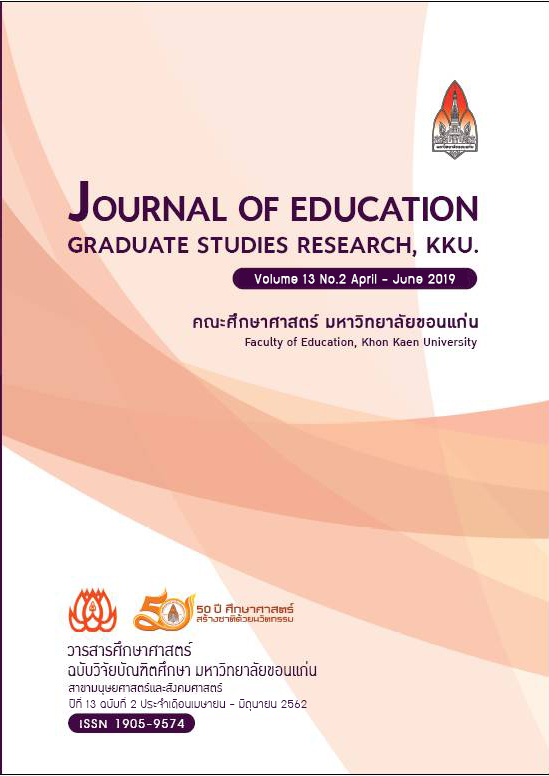The Effects of Modeling, Verbal Prompting and Social Reinforcement on Absent-Minded Behavior for Children with Autism
Main Article Content
Abstract
This is a study of the effects of modeling, verbal prompting and social reinforcement on absent-minded behavior for children with autism. The targets were 8-12 year old students with autism at the Special Education Center, Educational Region 9, Khon Kaen Province, have been diagnosed with autism, were absent-minded behavior and received parental consent to participate in the research, between 21st August 2018 to 20th October 2018. The instruments used in this study were an absent-minded behavior observation form and 5 Individual Implementation Plans (IIPs). A single subject design (A-B-A) was used in this research. The A-B-A design consisted 3 phases; That is a baseline phase (A1), an intervention phase (B) and a withdrawal phase (A2). By using basic statistics, include average and line graph.
The research results found:
In this study, modeling, verbal prompting and social reinforcement could decrease the absent-minded behavior for three children with autism. The first children with autism, The first period (A1), the baseline period (experiment) the mean of the frequency of the absent-minded behavior was 12.1, the second period (B), the experimental period, the mean of the frequency of the absent-minded behavior was 8.9 and the third period (A2), the withdrawal period, the mean of the frequency of The absent-minded behavior was 9.2. The second children with autism, The first period (A1), the baseline period (experiment) the mean of the frequency of the absent-minded behavior was 13.33, the second period (B), the experimental period, the mean of the frequency of the absent-minded behavior was 9.15 and the third period (A2), the withdrawal period, the mean of the frequency of The absent-minded behavior was 11.9. And the third children with autism, The first period (A1), the baseline period (experiment) the mean of the frequency of the absent-minded behavior was 11.8 , the second period (B), the experimental period, the mean of the frequency of the absent-minded behavior was 7.85 and the third period (A2), the withdrawal period, the mean of the frequency of The absent-minded behavior was 10.8.
Article Details
References
จิตติมา วัชรเสถียร. (2556). ผลของการใช้การชี้แนะร่วมกับการเสริมแรงเพื่อลดพฤติกรรมไม่ตั้งใจเรียนของเด็กออทิสติก. วิทยานิพนธ์ปริญญาศึกษาศาสตรมหาบัณฑิต สาขาจิตวิทยาการศึกษาพิเศษ บัณฑิตวิทยาลัย มหาวิทยาลัยศิลปากร.
ทวีศักดิ์ สิริรัตน์เรขา. (2548). คู่มือออทิสติก สำหรับผู้ปกครอง. กรุงเทพฯ: คุรุสภาลาดพร้าว.
ผดุง อารยะวิญญู. (2542). การเรียนร่วมระหว่างเด็กปกติกับเด็กที่มีความต้องการจำเป็นพิเศษ. มหาวิทยาลัยศรีนครินทรวิโรฒ. กรุงเทพฯ: แว่นแก้ว.
พระราชบัญญัติการจัดการศึกษาสำหรับคนพิการ พ.ศ. 2551. (2551). ค้นเมื่อ วันที่ 27 มกราคม พ.ศ. 2551, จาก https://th.wikisource.org/wiki/พระราชบัญญัติการจัดการศึกษาสำหรับคนพิการ_พ.ศ._2551.
ยุพิน โกสูงเนิน. (2546). ผลการใช้เทคนิคเบี้ยอรรถกรและเทคนิคการเสริมแรงทางสังคมต่อพฤติกรรมส่งการบ้าน. วิทยานิพนธ์ปริญญาการศึกษามหาบัณฑิต สาขาวิชาจิตวิทยาการศึกษา บัณฑิตวิทยาลัย มหาวิทยาลัยมหาสารคาม.
รัฐธรรมนูญแห่งราชอาณาจักรไทย พ.ศ. 2560. (2560). ค้นเมื่อ วันที่ 6 เมษายน พ.ศ. 2560, จาก http://www.ratchakitcha.soc.go.th/DATA/PDF/2560/A/040/1.PDF
ลัดดาวัลย์ วรพันธุ์. (2550). การเปรียบเทียบผลของการใช้เทคนิคการชี้แนะด้วยวาจา การเสริมแรงทางสังคมและการชี้แนะด้วยวาจาควบคู่กับการเสริมแรงทางสังคม ที่มีต่อพฤติกรรมตั้งใจเรียนวิชาภาษาอังกฤษของนักเรียน. วิทยานิพนธ์ปริญญาการศึกษามหาบัณฑิต สาขาวิชาจิตวิทยาการศึกษา บัณฑิตวิทยาลัย มหาวิทยาลัยมหาสารคาม.
ศศิธร สังข์อู๋. (2547). ผลของการใช้เทคนิคตัวแบบ การชี้แนะ และการเสริมแรงทางบวกที่มีต่อพฤติกรรม ความร่วมมือของเด็กออทิสติกก่อนวัยเรียน. วิทยานิพนธ์ปริญญาการศึกษามหาบัณฑิต สาขาจิตวิทยาพัฒนาการบัณฑิตวิทยาลัย มหาวิทยาลัยศรีนครินทรวิโรฒ.
สมโภชน์ เอี่ยมสุภาษิต (2550). ทฤษฎีและเทคนิคการปรับพฤติกรรม Theories and Teaching in Behavior Modification. กรุงเทพฯ: สำนักพิมพ์แห่งจุฬาลงกรณ์มหาวิทยาลัย.
สิริพร ศิริฟอง และปิยะวรรณ ศรีสุรักษ์. (2559). การลดพฤติกรรมไม่อยู่นิ่งของนักเรียนที่มีภาวะออทิสซึม โดยใช้เทคนิคสโนซีเล็นกับการเสริมแรงด้วยเบี้ยอรรถกร. วารสารศึกษาศาสตร์ ฉบับวิจัยบัณฑิตศึกษา มหาวิทยาลัยขอนแก่น, 10(4), 133-137.
สุรางค์ โค้วตระกูล. (2556). จิตวิทยาทางการศึกษา. พิมพ์ครั้งที่ 11. กรุงเทพฯ: จุฬาลงกรณ์มหาวิทยาลัย.
อัญชลี สารรัตนะ. (2561). การวิจัยเชิงทดลองแบบกลุ่มตัวอย่างเดี่ยว Single-Subject Experimental Research. ขอนแก่น: คณะศึกษาศาสตร์ มหาวิทยาลัยขอนแก่น.
Gawley, E. M. (2016). Effects of discrete trial training and peer modeling on imitation. University of Nebraska at Omaha.
Greer, R. D. (2014). The Effects of Social Listener Reinforcement and Video Modeling on the Emergence of Social Verbal Operants in Preschoolers Diagnosed with Autism and Language Delays. United States. Columbia University.
Lindeman, K. W. (2015). The Effects of Visual Cues, Prompting, and Feedback within Activity Schedules on Increasing Cooperation between Pairs of Children with Autism Spectrum Disorder. United States. Hofstra University.

